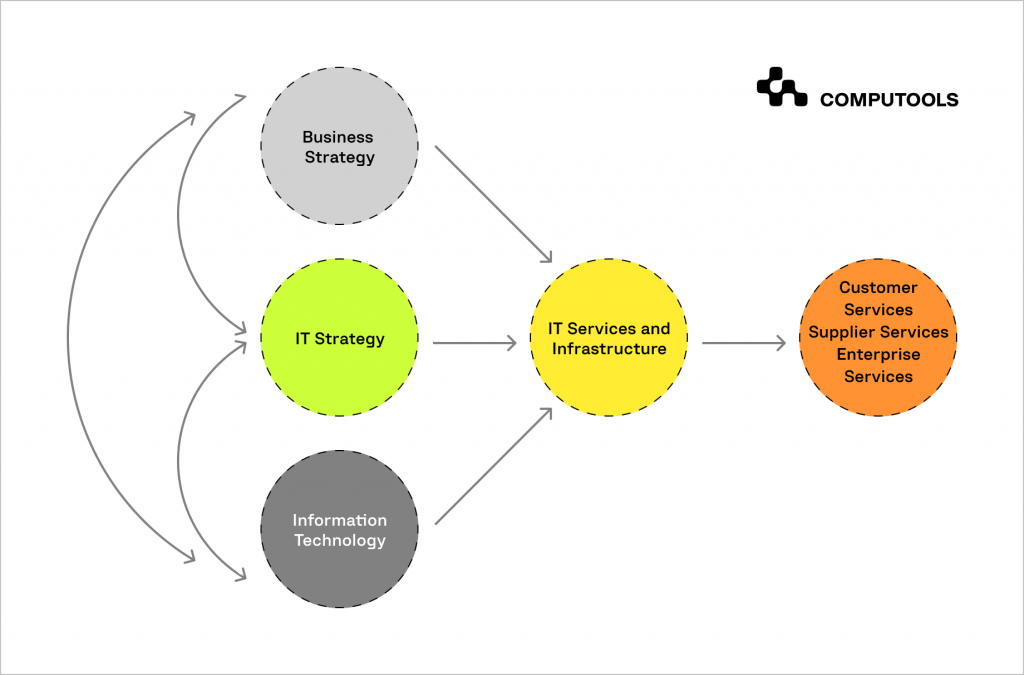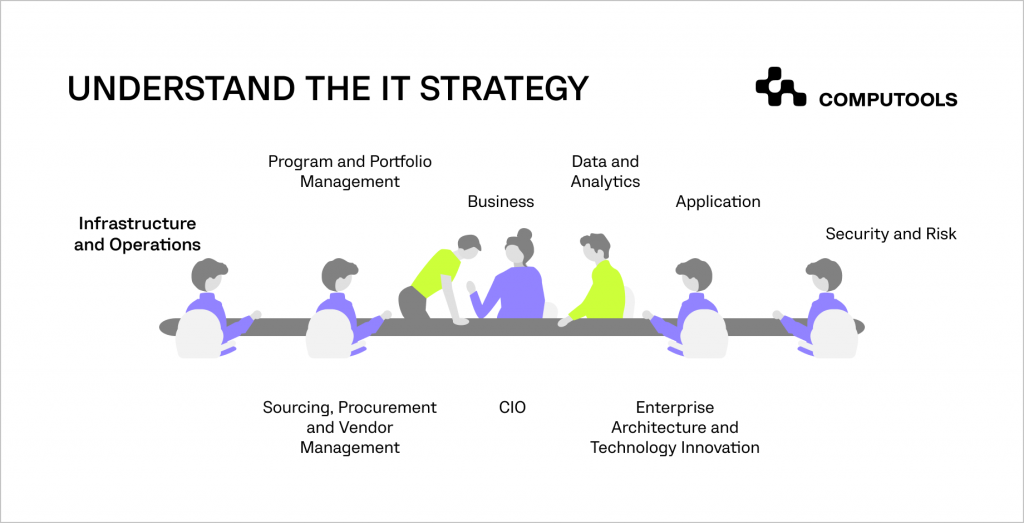A solid IT infrastructure strategy is critical to driving business growth and preserving a competitive advantage in today’s fast-paced corporate environment. I&O leaders frequently create strategy documents that read like technology adoption road maps.
However, focusing primarily on operational “how” and “when” questions ignores the importance of strategic ideas and definitions of success.
It is important to avoid typical errors when developing an I&O strategy. This blog post provides an overview of the entire strategy-building process to identify goals and actions that support your aims.
Business IT Infrastructure Strategy
The services a company provides to its customers, suppliers and employees are directly dependent on its business IT infrastructure strategy.
An ideal IT infrastructure supports both the company’s business and information systems strategy. New information technologies significantly affect business and IT strategies and the services that can be provided to customers.

IT infrastructure can be viewed as a set of technology or service clusters.
The service approach focuses on the services provided by hardware and software, such as:
• computing platforms
• telecommunications
• physical facilities management
• application software
• data management
• IT governance
• IT standards
• IT education and research and development
The service platform approach emphasises the business value that IT infrastructure provides.
Components of IT Infrastructure Strategy
The components of a business IT infrastructure strategy serve as the foundation for developing and managing a successful information technology system.
The most critical components of the plan are hardware, software, and networks.
• Hardware refers to all physical equipment required to run an information technology infrastructure. This can encompass desktops, laptops, tablets, servers, and data centres.
These devices serve as the foundation for the entire IT system, providing fundamental processing and storage capabilities.
• Software encompasses a wide range of applications and systems necessary for corporate operations. This comprises operating systems, content management systems, visualisation software, CRM, ERP, and web servers. The software manages data, supports corporate operations, and interacts with users.
• Networks are important to the integration of all components of IT infrastructure strategy. They use servers, data lines, hubs, switches, and routers to communicate between devices and connect them to the Internet.
Firewalls and other security mechanisms safeguard these networks against external threats. As part of IT infrastructure management, it is critical to remember that all components must operate together to deliver the required functionality, security, and scalability.
This includes creating an architectural vision based on medium- and long-term goals, as well as implementing best practices and standards to maintain the IT system’s reliability and efficiency.
Steps to Build an IT Infrastructure Strategy
Understanding how IT strategy aligns with strategic plans is critical. Use business drivers to map infrastructure nodes to workload types.
Identify key nodes and core architecture to create recommendations for future changes. Apply pre-designed templates when implementing new workloads. This will allow I&O Teams to quickly adapt infrastructure strategies to meet new business needs.
When designing future infrastructure, focus on business outcomes, not just technical requirements. Start by analysing how different infrastructure delivery options can meet business values and determine the best workload placement strategies.
Evaluate the pros and cons of each possible location or node, considering their impact and value through interaction with business partners, and assign appropriate weightings:
• What are the possible consequences for the company or customers if this workload fails? How will other workloads be affected?
• Does this workload need high performance to run queries, analyse data or conduct research?
• Do data location laws and other regulations require specific workload placement? Do audit or compliance requirements that require localised placement need to be met?

Here are some important aspects to consider when you Build an IT Infrastructure Strategy:
1. Cost reduction. Because workload requirements can change, flexibility in on-site resources is necessary. The ability to quickly scale resources on demand helps optimise costs.
2. Downtime prevention. For client workloads, avoiding downtime is critical, as problems spread quickly through social media, which can negatively impact a company’s reputation.
3. Staff training. Training new employees is a costly and time-consuming process. With the rapid introduction of new workloads, team skills and training becomes key.
It’s important to create an environment for continuous learning to automate processes and adopt new practices.
Flexible and Adaptable IT Infrastructure

In a world dominated by agility and cloud technology, I&O leaders face constant change. The key challenge in developing adaptable IT infrastructure strategies is the ability to embrace and plan for uncertainty.
Workloads should be placed where it brings the most business value. Sometimes this requires localised vendors to improve customer availability or spreading data across different countries to meet regulatory requirements. Flexibility in placement is a key element of the strategy.
Linear infrastructure growth is no longer relevant. Today’s enterprises need the ability to adapt quickly to change, scaling up or down as needed.
Infrastructure components may be needed for different periods, from a few hours to several years. It is important to accurately define their functions and types of workloads to minimise complexity and avoid creating hard-to-manage temporary solutions.
I&O teams must implement solutions quickly to avoid missing market opportunities and meet business requirements. The complex, elaborate solutions of the past become a barrier to flexible IT infrastructure for businesses.
Business Role of IT Infrastructure
IT infrastructure plays a critical role in business. It is part of the business and technology management processes. This means that it is essential for efficient management and production in a company.
IT infrastructure strategies must be carefully planned and integrated into the overall process of creating the final product, just like other tools of production.
Problems of inadequate IT infrastructure:
• A poorly designed IT infrastructure can lead to disruptions, inefficiencies, and even business process stoppages.
• Replacing or modernising IT infrastructure requires significant efforts such as process design and possible interference with existing workflows.
Design and modernisation:
• A successful IT infrastructure strategy design, like any other production tool, should include a pre-feasibility study and possibly due diligence.
• The transition to new technologies should be accompanied by modernisation planning and design to take into account all aspects of integrating new solutions.
Future and development:
• Technology is constantly evolving, and what is used today may change in decades to come. Hence, companies must be prepared to adapt and update their IT infrastructure in the future.
Thus, IT infrastructure is not just a set of technologies, but an important part of business processes that requires careful planning, integration and regular updates to keep the business competitive and efficient.

Computools
Software Solutions
Computools is an IT consulting and software engineering company that delivers innovative solutions to help businesses unlock tomorrow. Our clients represent a wide range of industries, including retail, logistics, finance, healthcare, and others.
Benefits for Business Growth
A strong IT infrastructure strategy is critical for corporate expansion, providing such benefits for business growth as better operational efficiency, scalability, and security.
Companies can use modern technologies to streamline processes, decrease costs, and stimulate creativity. Efficient IT infrastructure also assures regulatory compliance and improves consumer experiences, which leads to smarter decisions and a competitive edge.
Overall, a well-designed IT infrastructure strategy promotes significant business progress and long-term success.
IT Infrastructure Strategies Across Domains
When developing IT infrastructure strategies, it is critical to tailor techniques to specific areas such as Software Engineering, web development, and mobile app development services.
Each of these domains has unique requirements and issues that necessitate specific solutions.
• Software Development Services rely significantly on a strong IT infrastructure to support continuous integration, development, and deployment processes. In this domain, effective solutions frequently require creating scalable environments for developing, testing, and staging.
Development teams must manage a variety of technologies and platforms, including integrated development environments (IDEs), version control systems, and automated testing frameworks.
Infrastructure must support seamless integration and deployment pipelines, allowing for regular updates and rapid iteration cycles.
Version control management, maintaining compatibility across diverse environments, and assuring security throughout the development lifecycle are among the challenges.
Solutions frequently include integrating cloud-based platforms for scalability, containerisation technologies such as Docker for consistent environments, automated testing and continuous integration/continuous deployment (CI/CD) procedures to streamline operations.
• Web Development Services necessitate infrastructure that enables high availability, performance, and scalability. Web applications must handle variable traffic loads, necessitating the use of elastic resources to effectively manage peak times.
Infrastructure strategies should prioritise building content delivery networks (CDNs) to reduce latency, using load balancers to distribute traffic, and providing redundancy to avoid downtime.
The challenges include managing web server speed, dealing with huge traffic quantities, and assuring data security and privacy.
Cloud services are commonly used to provide scalable processing power and storage, CDN services to improve content delivery speed, and improved security mechanisms to secure user data.
• Mobile App Development Services necessitate infrastructure that facilitates app testing, deployment, and maintenance across various platforms, including iOS and Android.
Strategies should take into account the necessity to test on several devices and operating system versions, as well as interact with backend services such as databases and APIs.
Mobile app architecture must be capable of handling frequent updates while also providing capabilities for monitoring app performance and user input.
The challenges include assuring interoperability across several devices, handling app updates, and maintaining backend integration.
Backend support is frequently provided via cloud services, mobile device management (MDM) solutions are implemented for testing and deployment, and analytics tools are used to evaluate app performance and user engagement.
In all of these sectors, a strategic approach to IT infrastructure ensures that technology matches with business objectives, meets operational demands, and scales with expansion.
Businesses can optimize their IT infrastructure by addressing industry-specific difficulties and applying focused solutions that improve productivity, performance, and overall success.
Conclusion
To summarise, having a strong business IT infrastructure plan is critical for modern organisations to prosper.
Companies can build an IT infrastructure that meets their changing requirements by focusing on strategic concepts, involving I&O teams, and assuring flexibility and adaptability.
To stay on track with corporate objectives and achieve long-term success, the strategy must be evaluated and adjusted on a regular basis.
Businesses should invest in developing an effective IT infrastructure strategy to promote development and innovation.
Don’t let an outdated or inefficient IT infrastructure hold your business back. Contact us today an info@computools.com for a free consultation from our experts and find out how we can help you optimise your infrastructure to meet your business goals.









“Computools was selected through an RFP process. They were shortlisted and selected from between 5 other suppliers. Computools has worked thoroughly and timely to solve all security issues and launch as agreed. Their expertise is impressive.”